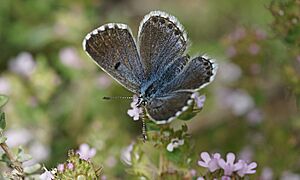Baton blue facts for kids
Quick facts for kids Baton blue |
|
|---|---|
 |
|
| Pseudophilotes baton female | |
| Conservation status | |
| Scientific classification | |
| Synonyms | |
|
The baton blue (Pseudophilotes baton) is a small, beautiful butterfly. It is part of the Lycaenidae family. These butterflies are often called "gossamer-winged butterflies." You can find the baton blue in central and southern Europe. Its home also stretches east across the Palearctic region to the Russian Far East.
Contents
About the Baton Blue
The baton blue butterfly is quite small. Its wingspan is usually about 10 to 11 millimeters. You can see these butterflies flying from April to September.
What it Looks Like
The top side of the baton blue's wings is generally dark. Males often have a dusting of blue scales. The forewing has a clear dark spot in the middle. The edges of the wings, called fringes, have small spots.
The underside of the wings is usually a lead-grey color. It has many eye-like spots, called ocelli. These spots are larger on the forewing. The hindwing often has reddish-yellow spots near the outer edge.
Life Cycle
The young butterflies, called larvae or caterpillars, have a unique look. They are light green with a blackish head. They have rosy-red spots on their back. These spots are separated by a purple line. White dots can be seen along their sides.
Baton blue caterpillars feed on several plants. They especially like thyme flowers. They also eat Clinopodium acinos, lavender, and Mentha plants. You can find the caterpillars in April and again in July.
The pupa is the stage between larva and adult butterfly. It is roundish and smooth. It has a clay-yellow color with darker wing cases. The pupa is usually found on the ground.
Where and How They Fly
Adult baton blue butterflies are active in May. They are also seen in August and September. They prefer very sunny, grassy hills and slopes. You can also find them in clearings in woods and along wide, sunny roads.
These butterflies usually fly short distances. They often land on grasses or plant tops. When they land, they keep their wings half-open and spread wide. Their flight is slow and a bit bouncy. They are not very shy around people.
In central Europe, you might see them one by one. But in southern Europe and North Africa, they are very common. They often fly in large numbers there.
Subspecies
A subspecies is a group of animals within a species. They are slightly different from other groups in the same species.
- Pseudophilotes baton baton: Found in southern and central Europe. Also in south-western Siberia and the Altai Mountains.
- Pseudophilotes baton jacuticus Korshunov & Viidalepp, 1980: Found in Yakutia, a region in Russia.
Why the Name "Baton Blue"?
The name baton comes from Classical tradition. It is named after Baton. He was a charioteer in ancient Greek mythology. Baton was the driver for a general named Amphiaraos.


